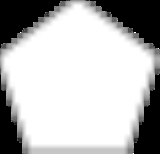
Vertex arrangement
Encyclopedia
In geometry
, a vertex arrangement is a set of points in space described by their relative positions. They can be described by their use in polytope
s.
For example a square
vertex arrangement is understood to mean four points in a plane, equal distance and angles from a center point.
Two polytopes share the same vertex arrangement if they share the same 0-skeleton
.
A vertex arrangement is often described by the convex hull
polytope which contains it. For example, the regular pentagram can be said to have a (regular) pentagonal vertex arrangement.
Infinite tilings can also share common vertex arrangements.
For example, this triangular lattice of points can be connected to form either isosceles triangles or rhombic
faces.
can also have the same edge arrangement which means they have similar vertex and edge arrangements, but may differ in their faces.
For example the self-intersecting great dodecahedron shares it edge arrangement with the convex icosahedron.
can also have the same face arrangement which means they have similar vertex, edge, and face arrangements, but may differ in their cells.
For example, of the ten nonconvex regular Schläfli-Hess polychora, there are only 7 unique face arrangements.
For example the grand stellated 120-cell and great stellated 120-cell, both with pentagram
mic faces, appear visually indistinguishable without a representation of their cells
:
advocates the term army for a class of polytopes that share an element arrangement. More generally he defines n-regiments for polytopes that share elements up to dimension n. So a regiment (1-regiment) shares the same edge and vertex arrangement. He called a set of polytopes with the same 2-regiment as a company.
Geometry
Geometry arose as the field of knowledge dealing with spatial relationships. Geometry was one of the two fields of pre-modern mathematics, the other being the study of numbers ....
, a vertex arrangement is a set of points in space described by their relative positions. They can be described by their use in polytope
Polytope
In elementary geometry, a polytope is a geometric object with flat sides, which exists in any general number of dimensions. A polygon is a polytope in two dimensions, a polyhedron in three dimensions, and so on in higher dimensions...
s.
For example a square
Square (geometry)
In geometry, a square is a regular quadrilateral. This means that it has four equal sides and four equal angles...
vertex arrangement is understood to mean four points in a plane, equal distance and angles from a center point.
Two polytopes share the same vertex arrangement if they share the same 0-skeleton
N-skeleton
In mathematics, particularly in algebraic topology, the n-skeleton of a topological space X presented as a simplicial complex refers to the subspace Xn that is the union of the simplices of X of dimensions m ≤ n...
.
Vertex arrangement
The same set of vertices can be connected by edges in different ways. For example the pentagon and pentagram have the same vertex arrangement, while the second connects alternate vertices. pentagon Pentagon In geometry, a pentagon is any five-sided polygon. A pentagon may be simple or self-intersecting. The sum of the internal angles in a simple pentagon is 540°. A pentagram is an example of a self-intersecting pentagon.- Regular pentagons :In a regular pentagon, all sides are equal in length and... |
 pentagram Pentagram A pentagram is the shape of a five-pointed star drawn with five straight strokes... |
A vertex arrangement is often described by the convex hull
Convex hull
In mathematics, the convex hull or convex envelope for a set of points X in a real vector space V is the minimal convex set containing X....
polytope which contains it. For example, the regular pentagram can be said to have a (regular) pentagonal vertex arrangement.
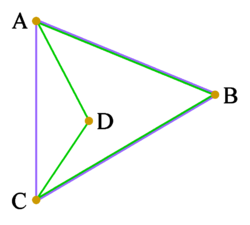 |
ABCD is a concave quadrilateral Quadrilateral In Euclidean plane geometry, a quadrilateral is a polygon with four sides and four vertices or corners. Sometimes, the term quadrangle is used, by analogy with triangle, and sometimes tetragon for consistency with pentagon , hexagon and so on... (green). Its vertex arrangement is the set {A, B, C, D}. Its convex hull is the triangle Triangle A triangle is one of the basic shapes of geometry: a polygon with three corners or vertices and three sides or edges which are line segments. A triangle with vertices A, B, and C is denoted .... ABC (blue). The vertex arrangement of the convex hull is the set {A, B, C}, which is not the same as that of the quadrilateral; so here, the convex hull is not a way to describe the vertex arrangement. |
Infinite tilings can also share common vertex arrangements.
For example, this triangular lattice of points can be connected to form either isosceles triangles or rhombic
Rhombus
In Euclidean geometry, a rhombus or rhomb is a convex quadrilateral whose four sides all have the same length. The rhombus is often called a diamond, after the diamonds suit in playing cards, or a lozenge, though the latter sometimes refers specifically to a rhombus with a 45° angle.Every...
faces.
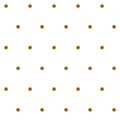 Lattice points |
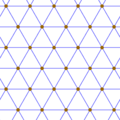 Triangular tiling |
 rhombic Rhombus In Euclidean geometry, a rhombus or rhomb is a convex quadrilateral whose four sides all have the same length. The rhombus is often called a diamond, after the diamonds suit in playing cards, or a lozenge, though the latter sometimes refers specifically to a rhombus with a 45° angle.Every... tiling |
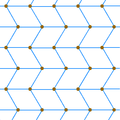 Zig-zag rhombic tiling |
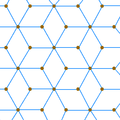 Rhombille tiling |
Edge arrangement
PolyhedraPolyhedron
In elementary geometry a polyhedron is a geometric solid in three dimensions with flat faces and straight edges...
can also have the same edge arrangement which means they have similar vertex and edge arrangements, but may differ in their faces.
For example the self-intersecting great dodecahedron shares it edge arrangement with the convex icosahedron.
 icosahedron Icosahedron In geometry, an icosahedron is a regular polyhedron with 20 identical equilateral triangular faces, 30 edges and 12 vertices. It is one of the five Platonic solids.... (20 triangles) |
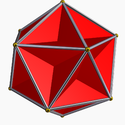 great dodecahedron (12 intersecting pentagons) |
Face arrangement
4-polytopesPolychoron
In geometry, a polychoron or 4-polytope is a four-dimensional polytope. It is a connected and closed figure, composed of lower dimensional polytopal elements: vertices, edges, faces , and cells...
can also have the same face arrangement which means they have similar vertex, edge, and face arrangements, but may differ in their cells.
For example, of the ten nonconvex regular Schläfli-Hess polychora, there are only 7 unique face arrangements.
For example the grand stellated 120-cell and great stellated 120-cell, both with pentagram
Pentagram
A pentagram is the shape of a five-pointed star drawn with five straight strokes...
mic faces, appear visually indistinguishable without a representation of their cells
Cell (geometry)
In geometry, a cell is a three-dimensional element that is part of a higher-dimensional object.- In polytopes :A cell is a three-dimensional polyhedron element that is part of the boundary of a higher-dimensional polytope, such as a polychoron or honeycomb For example, a cubic honeycomb is made...
:
 Grand stellated 120-cell (120 small stellated dodecahedrons) |
 Great stellated 120-cell (120 great stellated dodecahedrons) |
Classes of similar polytopes
George OlshevskyGeorge Olshevsky
George Olshevsky is a freelance editor, writer, publisher, amateur paleontologist, and mathematician living in San Diego, California.Olshevsky maintains the comprehensive online Dinosaur Genera List...
advocates the term army for a class of polytopes that share an element arrangement. More generally he defines n-regiments for polytopes that share elements up to dimension n. So a regiment (1-regiment) shares the same edge and vertex arrangement. He called a set of polytopes with the same 2-regiment as a company.
See also
- n-skeletonN-skeletonIn mathematics, particularly in algebraic topology, the n-skeleton of a topological space X presented as a simplicial complex refers to the subspace Xn that is the union of the simplices of X of dimensions m ≤ n...
- a set of elements of dimension n and lower in a higher polytope. - Vertex figureVertex figureIn geometry a vertex figure is, broadly speaking, the figure exposed when a corner of a polyhedron or polytope is sliced off.-Definitions - theme and variations:...
- A local arrangement of faces in a polyhedron (or arrangement of cells in a polychoron) around a single vertex.

